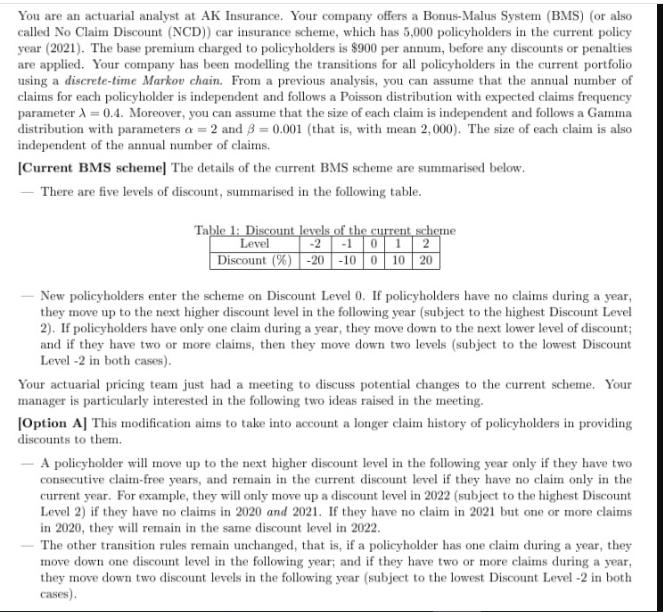Answered step by step
Verified Expert Solution
Question
1 Approved Answer
You are an actuarial analyst at AK Insurance. Your company offers a Bonus-Malus System (BMS) (or also called No Claim Discount (NCD)) car insurance

You are an actuarial analyst at AK Insurance. Your company offers a Bonus-Malus System (BMS) (or also called No Claim Discount (NCD)) car insurance scheme, which has 5,000 policyholders in the current policy year (2021). The base premium charged to policyholders is $900 per annum, before any discounts or penalties are applied. Your company has been modelling the transitions for all policyholders in the current portfolio using a discrete-time Markov chain. From a previous analysis, you can assume that the annual number of claims for each policyholder is independent and follows a Poisson distribution with expected claims frequency parameter A=0.4. Moreover, you can assume that the size of each claim is independent and follows a Gamma distribution with parameters a = 2 and 3 = 0.001 (that is, with mean 2,000). The size of each claim is also independent of the annual number of claims. [Current BMS scheme] The details of the current BMS scheme are summarised below. There are five levels of discount, summarised in the following table. Table 1: Discount levels of the current scheme Level Discount (%) -2-101 2 -20 -10 0 10 20 New policyholders enter the scheme on Discount Level 0. If policyholders have no claims during a year, they move up to the next higher discount level in the following year (subject to the highest Discount Level 2). If policyholders have only one claim during a year, they move down to the next lower level of discount; and if they have two or more claims, then they move down two levels (subject to the lowest Discount Level -2 in both cases). Your actuarial pricing team just had a meeting to discuss potential changes to the current scheme. Your manager is particularly interested in the following two ideas raised in the meeting. [Option A] This modification aims to take into account a longer claim history of policyholders in providing discounts to them. - A policyholder will move up to the next higher discount level in the following year only if they have two consecutive claim-free years, and remain in the current discount level if they have no claim only in the current year. For example, they will only move up a discount level in 2022 (subject to the highest Discount Level 2) if they have no claims in 2020 and 2021. If they have no claim in 2021 but one or more claims in 2020, they will remain in the same discount level in 2022. The other transition rules remain unchanged, that is, if a policyholder has one claim during a year, they move down one discount level in the following year; and if they have two or more claims during a year, they move down two discount levels in the following year (subject to the lowest Discount Level -2 in both cases).
Step by Step Solution
There are 3 Steps involved in it
Step: 1

Get Instant Access to Expert-Tailored Solutions
See step-by-step solutions with expert insights and AI powered tools for academic success
Step: 2

Step: 3

Ace Your Homework with AI
Get the answers you need in no time with our AI-driven, step-by-step assistance
Get Started


